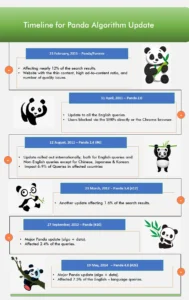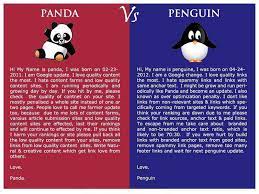Introduction to the latest Algorithm Update..
The Google Algorithm Update stands as a pivotal milestone in the ever-evolving landscape of search engine algorithms. As a crucial facet of Google’s broader algorithm updates, Panda revolutionized how content quality and relevance are assessed on the web. Originally introduced in 2011, Panda aimed to penalize low-quality, spammy content while rewarding sites that provided valuable, authoritative information to users.
Through sophisticated algorithms and machine learning, Google Panda scrutinizes website content, emphasizing factors like originality, relevance, and user engagement. Websites deemed to offer subpar content or engage in questionable SEO tactics risk significant drops in search engine rankings, while those adhering to quality guidelines stand to gain visibility and traffic.
Understanding the nuances of Google Panda is essential for webmasters, content creators, and SEO practitioners striving to maintain and enhance their online presence. In this exploration of the Google Panda update, we uncover its intricacies, explore its implications, and equip you with actionable insights to navigate the evolving terrain of search engine optimization effectively.
Unveiling Google Panda: Navigating the Latest Google Algorithm Update
Google Panda is a significant algorithm update introduced by Google to refine search results by penalizing websites with low-quality or duplicate content while rewarding sites with high-quality, original content. It’s a crucial part of Google’s broader algorithm updates aimed at improving user experience and content relevance in search results.
Google Panda is an integral part of Google’s search algorithm discovered to filter out and lower the rank websites with thin or low-quality content and web spam. It was first released in 2011 as a part of Google’s efforts to eliminate black hat SEO practices and spam.
Google frequently checks its algorithm to deliver the most relevant answers to users. But while these changes are often subtle enough, the same can’t be said for the Panda update – arguably one of the most significant modifications to Google’s algorithm.
Now Today Google Panda is integrated into the algorithm and is being improved continuously.According to Amit Singhal, this name actually refers to the software engineer of google who played an integral role in making the update possible – Navneet Panda.
why did Google Create Panda ?
Google created the Panda update as part of its continuous effort to improve the quality of search results for users. With the increasing prevalence of low-quality, spams, and duplicate content in the website.The Panda update specifically targeted websites engaging in content farming, keyword stuffing, and other manipulative tactics to artificially boost their search engine rankings.
By implementing the Panda update, Google aimed to enhance the overall user experience by presenting searchers with more relevant, authoritative, and trustworthy content. This aligns with Google’s overarching goal of providing users with the most useful and informative results to their queries, thereby maintaining its position as the leading search engine.

Why is Google Panda important?
Google Panda is important because it significantly influences the ranking and visibility of websites in Google’s search results, making it a crucial aspect of the latest Google algorithm updates. As part of Google’s ongoing effort to prioritize high-quality content and enhance user experience, the Panda update evaluates the quality, relevance, and uniqueness of web content.
Furthermore, Google Panda plays a pivotal role in combating content spam, keyword stuffing, and other manipulative SEO tactics that degrade the overall quality of search results. By rewarding websites with original, informative, and engaging content, Panda ensures that users receive the most relevant and valuable information in response to their queries.
In summary, Google Panda is important because it promotes content quality, improves user satisfaction, and maintains the integrity of Google’s search ecosystem, making it a critical component of the latest Google algorithm updates.
Best SEO Implementations for Google Panda..
The best implementations of Google Panda involve focusing on creating high-quality, original, and engaging content that resonates with your target audience. Here are some key strategies to ensure compliance and success with the latest Google algorithm update:
1. Content Quality: Prioritize creating content that is valuable, informative, and relevant to your audience’s interests and needs. Aim to provide unique insights, original perspectives, and comprehensive information that distinguishes your content from competitors.
2. User Experience: Enhance the overall user experience of your website by optimizing site speed, mobile responsiveness, and navigation. Make it easy for users to find relevant information and engage with your content intuitively.
3. Content Structure: Organize your content logically with clear headings, subheadings, and bullet points to improve readability and comprehension. Break up large blocks of text and use multimedia elements such as images, videos, and infographics to enhance engagement.
4. Keyword Optimization: Conduct thorough keyword research to identify relevant keywords and phrases that align with your content and target audience. Incorporate keywords naturally into your content, titles, headings, and meta descriptions without resorting to keyword stuffing.
5. Regular Content Audits: Conduct periodic audits of your website content to identify and address any low-quality, duplicate, or outdated content. Remove or update content that no longer serves a purpose or fails to meet quality standards.
6. Engagement Metrics: Monitor user engagement metrics such as bounce rate, time on page, and click-through rate to gauge the effectiveness of your content. Identify areas for improvement and make data-driven decisions to optimize user engagement and satisfaction.
By implementing these best practices, you can not only ensure compliance with the latest Google algorithm update but also enhance the overall quality and relevance of your website content, resulting in improved search rankings, increased organic traffic, and enhanced user satisfaction.

How Google Panda Evaluates Content Quality ?
Google Panda evaluates content quality through a variety of criteria to ensure that users are presented with high-quality, relevant, and authoritative information in search results, which aligns with the latest Google algorithm update. Here are some key factors that Google Panda considers when assessing content quality:
1. Originality: Google Panda looks for original and unique content that provides valuable insights, perspectives, or information not readily available elsewhere on the web. It penalizes websites that publish duplicate or plagiarized content.
2. Relevance: Content relevance is crucial for Google Panda. It assesses how well content matches the intent of user queries and whether it addresses the topics or keywords effectively. Relevant content is more likely to rank higher in search results.
3. Depth and Breadth: Panda favors content that offers comprehensive coverage of a topic, providing in-depth analysis, thorough explanations, and relevant supporting details. Content that is shallow or lacks substance may be deemed low-quality.
4. Authority and Trustworthiness: Google Panda prioritizes content from authoritative sources that demonstrate expertise, credibility, and trustworthiness in their respective fields. It assesses factors such as author reputation, site reputation, and citations from reputable sources.
5. User Engagement: Panda considers user engagement metrics such as dwell time, bounce rate, and click-through rate as indicators of content quality and relevance. Content that keeps users engaged, encourages interaction, and satisfies user intent is more likely to be considered high-quality.
6. Readability and Accessibility: Panda evaluates the readability and accessibility of content, including factors such as clarity, coherence, grammar, and formatting. Content that is well-structured, easy to read, and accessible across devices enhances the user experience.
Overall, Google Panda employs a sophisticated algorithmic approach to assess content quality and ensure that users are presented with the most valuable and relevant information in search results. By focusing on originality, relevance, depth, authority, user engagement, and readability, website owners and content creators can optimize their content to meet the standards set by the latest Google algorithm update and improve their search rankings and visibility accordingly.
What Triggers a Google Panda Penalty?
Duplicate Content
Duplicate content refers to identical or highly similar content on multiple pages. Either within a single website (internal duplicate content) or across different domains (external duplicate content).
If the similarities are minimal and unintentional, your site is unlikely to be penalized. But if it appears the duplicate content is deceptive and manipulates search engine results, you’ll likely move down the SERPs.
Low-Quality Content
Panda was based on the idea that low-quality content doesn’t provide value to users. Therefore, it shouldn’t be at the top of the SERPs.The algorithm will likely prevent this content from ranking high on the SERPs based solely on its lack of readability.
It might seem like an extreme example. But this kind of content was found on page one of Google before Panda. For your content to rank highly today, you need to avoid tactics like this.
Thin Content
Google Panda specifically targets thin content by penalizing websites that prioritize quantity over quality, focusing on metrics like user engagement, bounce rates, and content depth to assess the value of web pages.
Thin content can include pages with little substantive content, such as doorway pages, affiliate pages with minimal unique content, and pages with auto-generated or scraped content.
Excessive Ads
One question Google uses to define a high-quality site is: “Does this article have an excessive amount of ads that distract from or interfere with the main content?”This means pages composed primarily of ads with little or no original content are considered low-quality.
We’re sure you’ve seen examples of pages filled with huge ads or images that impede your ability to read the text—this is something Panda aims to combat.
TimeLine
The timeline of the Panda update, a significant component of the latest Google algorithm updates, spans from its initial launch in February 2011 to its integration into Google’s core ranking algorithm in September 2014.
Throughout this period, Google rolled out several iterations and refinements of the Panda update to improve search quality and combat low-quality content, with periodic updates and refreshes continuing thereafter.

Basic Difference Between Pnda & Penguin Update....
Thus, the basic difference between Google Panda and Google Penguin is that Panda targets sites that are spam and Penguin deals with bad linking and overstuffing of keywords.
- Panda normally does not target individual pages. So in case your website has too little content that is original and too much of sparse and stolen content you will be punished by Panda. However, Penguin only attacks individual pages. However, there is a possibility that your entire site may be punished if it has too much spam by way of keywords.
- In case of Panda there is no use sending a recovery request. The case is almost similar in Penguin as well but there is a smidgen of hope in case of manual warnings. With Panda it will not help if you just remove the links manually since content is of greater importance over here. However, with Penguin manual removal can come in handy but then there should be enough time.
- With Panda if you have removed the objectionable content then by the time the next update comes in your site can recover. However, with Penguin it will take more time since the updates are not as regular as Panda.


Conclusion
In conclusion, the Panda update stands as a pivotal element of the latest Google algorithm update, aiming to elevate the quality and relevance of search results by penalizing low-quality, spammy, and duplicate content while promoting websites with valuable, original, and user-centric content. Through its various iterations and refinements, Panda has reshaped the digital landscape, emphasizing the importance of content quality, relevance, and user experience in search engine rankings.
Website owners, content creators, and SEO practitioners must prioritize creating high-quality, authoritative content that adds value to users to thrive in the ever-evolving realm of search engine optimization. As Panda continues to evolve and integrate into Google’s core ranking algorithm, maintaining a focus on content quality and relevance remains paramount for achieving sustained visibility and success in online search.
Certainly! Here’s a concise self-introduction for a freelance digital marketer in Kerala:
—
Hello! I’m Arsha Jayalal, a freelance digital marketer based in beautiful Kerala. With a passion for digital strategies and a keen eye for detail, I specialize in helping businesses in Kerala amplify their online presence and reach their target audience effectively. Let’s connect and explore how I can support your digital marketing goals!
—
Feel free to adapt it to fit your own style and experiences!
Contact Me for More Details

